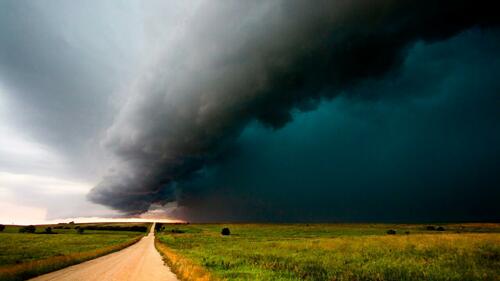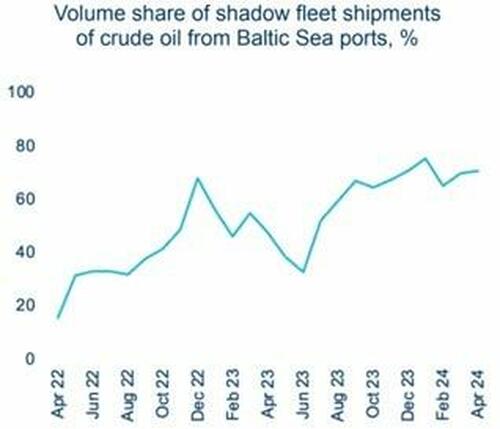
The Quiet Before The Storms In Ukraine, Gaza, And Taiwan?
Authored by Victor Davis Hanson via American Greatness,
There are three current hot or cold wars: on the Ukrainian border, in the regions surrounding Israel, and in the strategic space between Taiwan and mainland China.
All three conflicts could not only expand within their respective theaters but also escalate to draw in the United States.
And all three involve nuclear powers.
-
Various Russian megaphones routinely threaten to use tactical nuclear weapons against Ukraine. Some boast about sending strategic nuclear bombs or missiles against its Western suppliers, especially as the costs of Russian aggression mount and the humiliation of Putin escalates.
-
Nuclear Israel and near-nuclear Iran have both exchanged attacks on their respective homelands—and promise to do so again.
-
China likewise on occasion existentially threatens Taiwan. Its freelancing generals and spokesmen periodically warn Japan and the U.S. of dire nuclear consequences should they intervene on Taiwan’s behalf.
In all these theaters, there superficially appears to be stasis and deadlock:
-
Israel is said to be bogged down in Gaza as it seeks to neutralize 400 miles of subterranean command-and-control installations and munitions, find and rescue surviving Israeli hostages, and take out the Hamas leaders. And no one believes that the degradation of Hamas will mark the end of the war, given the agendas of Hezbollah, the Houthis, and Iran, to attack periodically and chronically the Jewish state.
-
Combined Russian and Ukrainian dead, wounded, and missing may be nearing one million. Experts argue about whether the current apparently successful Ukrainian counteroffensive towards Kursk inside Russia was merely a demonstration to gain diplomatic concessions. Or was it designed to take and hold ground inside the Russian homeland? Or intended to draw off Russian offensives to the southeast? Some call it brilliantly conceived but dangerous—given the risk of its ending like the ill-fated Battle of the Bulge German offensive of 1945 that achieved startling initial success but was soon ground down by superior numbers and ultimately weakened the overall German defense.
-
China has stepped up its harassment of Philippine forces and its rhetoric. It has upped its intrusions into Taiwanese airspace and waters while cementing strategic partnerships with Russia and Iran, even as it courts India and Turkey. Yet for now, China is not especially eager to attack Taiwan, given that it feels it is steadily gaining momentum in psychologically, strategically, and politically strangling the Taiwanese.
Confusion and strategic pauses for the brief moment mark all these conflicts. In part, the hiatuses arose because of uncertainty surrounding the murky intentions and role of the United States. The latter is bogged down in an unpredictable if not bizarre election year, compounded by ambiguity about who is actually in control of the country and for how long, and who will be president after January 2025.
The 2024 race saw the first-ever presidential debate held well before the formal nomination of candidates, the sudden forced removal of President Biden from his reelection candidacy, the abrupt coronation of a once-deemed-unimpressive Kamala Harris as his replacement, the inability or unwillingness of Harris to meet the media or give interviews, the continued apparent debility of Biden as he enters the last six months of his presidential tenure, the assassination attempt on Donald Trump, and the near-even presidential polls.
While Russian and Ukrainian forces advance and retreat along their shared border, most experts privately feel that there is quiet consensus about an eventual armistice to end the Somme-like bloodbath. This will involve recognition of Russia’s control over the Donbas and Crimea that Putin attacked and de facto absorbed in 2014; a demilitarized border; and an autonomous and heavily armed but non-NATO Ukraine.
Currently, Ukraine is running out of manpower, given its losses, draft problems, and a quarter of the population having fled the country. Russia has suffered twice as many casualties as Ukraine and faced blows to its military prestige. It has so far found no tactical or strategic pathway to absorb Ukraine as it intended with its February 2022 surprise attack on Kyiv.
Yet the apparent ossification on the border may be illusory. If either side cracks and its enemy suddenly makes dramatic advances, a dangerous escalation could ensue, and rapidly so. Russia will likely not allow Ukraine to occupy for any extended period any Russian territory and will up its threats toward what it sees as an exhausted Ukraine and a tired NATO partnership.
And NATO and the United States will likely never allow Russia to annex Ukraine in toto beyond the Donbas and Crimea. The longer the ensuing stagnation, the more likely one side will seek a dramatic breakthrough, and so the more likely becomes a greater war with third-party intervention and deadlier weapons.
Turning to the second conflict, we find that Iran is now in a dangerous position of its own making. It has loudly promised Israel and boasted to the Muslim world that it will attack the Jewish homeland for a second time within a year. Hezbollah threatens to join in, perhaps along with anemic contributions from Hamas and the Houthis.
Yet does Iran really believe that even a missile and drone launch twice the size of its last huge but failed barrage—say 640 projectiles—will seriously injure Israel? Even with the confusion and chaos in the U.S., is Tehran really convinced that the U.S. and some of its European and Arab allies will not again intervene to protect their own assets or their own or international airspace, by knocking down Iranian aerial attacks?
In short, Iran’s rhetoric and the provocations of its satellites have put it in a lose/lose situation: to save face the theocracy feels it must honor its threats and attack Israel, but it also knows it may not be able to do much damage, while earning a second retaliatory response potentially far more grievous and far more warranted in international eyes than Israel’s prior successful but largely demonstrative missile launch.
Ditto Hezbollah. It hopes that its some 150,000 rockets and drones will do real damage in concert with an Iranian attack but accepts that it will certainly earn in response a devastation of Shiite Beirut and its environs far in excess of what it suffered in 2006. The damage from that conflict took a generation to repair, with hundreds of miles of roads, thousands of homes, and billions of dollars in infrastructure destroyed.
So, like the Ukrainian conflict, the Middle East war is only temporarily on pause. And it will continue until Iran or Israel seeks to break the stalemate in a second phase that would make the Gaza campaign seem minor in comparison and be far more likely to draw in outside powers—especially if the United States appears feeble and unable to protect its traditional ally Israel.
As for the third, still-bloodless conflict: China envisions strategy globally rather than regionally. It helps to fuel the stalemate in Ukraine, on the grounds that its traditional rival turned temporary friend Russia is hurting the West by consuming its money, weapons, and attention—while conveniently hurting itself in the process.
China is openly aiding Iran, not because it is especially friendly to radical Islam (cf. its treatment of the Uyghurs) or innately hostile to the Jewish state. Instead, it simply welcomes these tensions that cause radical domestic upheaval and political dissension inside America, while drawing U.S. naval and air assets far away from the South China Sea.
China’s operating principle seems to be to watch and wait for the outcome of the wars in Ukraine and the Middle East, given that both tax Western powers. It is eager and patient to see how the conflicts end, especially whether Russia achieves by force its apparent goals, and whether Iran and its proxies permanently redefine the future of the Middle East. These outcomes will serve to indicate the level of potential Western resistance to or intentional condemnation of its own planned annexation of Taiwan.
In conclusion, we are entering a very dangerous five-month period.
Joe Biden has been judged by the American people in the polls as too enfeebled to be reelected and declared by his own party to be too cognitively challenged to remain its nominee. That may suggest to foreign risk-takers that the U.S. president is deemed unfit by Americans themselves and thus conclude there might be a vacuum of rapid-response leadership at the White House.
The unspoken corollary is that the American people and both their political parties are certain that, while Biden is incapable of continuing as a normally engaged president through the last half-year of his tenure, he will nevertheless inevitably do so. And that conclusion is likely shared by enemies abroad, who may surmise that if there ever was a time to alter the current geostrategic map or the relative balance of power, that rare occasion is now on the horizon.
Loading…
Originally Posted at; https://www.zerohedge.com//
Stay Updated with news.freeptomaineradio.com’s Daily Newsletter
Stay informed! Subscribe to our daily newsletter to receive updates on our latest blog posts directly in your inbox. Don’t let important information get buried by big tech.
Current subscribers:








